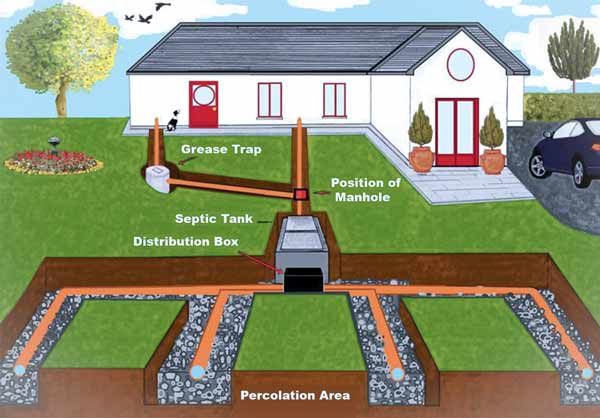No, driving over your septic drain field is not recommended. Driving over the drain field can compact the soil and damage the pipes, leading to potential septic system failure.
A septic drain field, also known as a leach field, is an essential part of a septic system that helps remove harmful substances from wastewater before it is absorbed into the ground. It consists of a network of perforated pipes buried in trenches filled with gravel or other aggregate materials.
These pipes distribute treated wastewater into the surrounding soil, where it undergoes further treatment and filtration. Maintaining the integrity of the drain field is crucial for the proper functioning of the septic system.
Driving heavy vehicles or machinery over the drain field can compact the soil, disrupt the pipe network, and compromise the system’s efficiency. It is best to avoid driving over the drain field area to ensure its long-term functionality and prevent costly repairs.

Contents
- Importance Of Septic Drain Field
- Understanding The Structure Of A Septic Drain Field
- Potential Risks Of Driving Over A Septic Drain Field
- Best Practices For Safely Navigating A Septic Drain Field
- Alternative Options For Accessing The Septic Tank
- Consequences Of Driving Over A Septic Drain Field
- Professional Assistance And Legal Considerations
- Frequently Asked Questions Of Can I Drive Over My Septic Drain Field
- Conclusion
Importance Of Septic Drain Field
Maintaining the integrity of your septic drain field is crucial for proper waste water disposal. Driving over the drain field can compact the soil, hinder drainage, and damage the pipes, leading to costly repairs. It’s essential to avoid any activity that can compromise the functionality of the drain field.
What Is A Septic Drain Field?
A septic drain field, also known as a leach field, is a crucial component of a septic system designed to disperse treated wastewater from the septic tank into the soil for further filtration and purification.
Why Is A Septic Drain Field Important?
The septic drain field plays a vital role in the proper functioning of a septic system by facilitating the final stage of wastewater treatment, allowing safe disposal of effluent without harming the environment or contaminating groundwater.
Understanding The Structure Of A Septic Drain Field
Understanding the structure and function of a septic drain field is crucial for maintaining a healthy and efficient septic system.
A septic drain field, also known as a leach field, is a vital component of the septic system that works to purify wastewater and allow it to return to the groundwater system.
To better understand the significance of a septic drain field, let’s delve into its components and how it functions.
Components Of A Septic Drain Field
A septic drain field typically consists of trenches or beds that are filled with gravel or other porous materials.
These trenches or beds are interconnected with perforated pipes, which distribute the effluent from the septic tank into the surrounding soil for further treatment and filtration.
The soil itself acts as a natural filter, removing contaminants and impurities from the wastewater as it percolates through the ground.
How Does A Septic Drain Field Work?
The septic drain field operates by dispersing the effluent from the septic tank into the soil, where it undergoes a natural filtration process.
As the effluent seeps through the soil, microorganisms break down harmful pathogens and organic matter, effectively treating the wastewater before it rejoins the groundwater.
This process ultimately helps to prevent contamination of the surrounding environment and protects public health.
Potential Risks Of Driving Over A Septic Drain Field
When it comes to the care and maintenance of your septic system, it’s crucial to be mindful of how you interact with the various components.
One key concern is the potential risks associated with driving over a septic drain field. Doing so can lead to several detrimental consequences, ultimately compromising the effectiveness and longevity of your septic system.
Compromising The Drainage System
Driving over a septic drain field can exert heavy pressure on the soil and the pipes beneath it. The excess weight can compact the soil, leading to a reduction in the soil’s ability to effectively absorb and disperse wastewater.
As a result, the drainage system becomes less efficient, potentially leading to backups and ponding in the field.
Damage To Pipes And Distribution Lines
The weight of vehicles can put undue stress on the pipes and distribution lines that make up the septic system. This increased pressure can cause the pipes to crack or become dislodged, resulting in leaks and reduced functionality.
Once damaged, these critical components are costly and complicated to repair, disrupting the overall performance of the septic system.
Contamination Of Groundwater
Driving over the septic drain field can also pose a risk of contaminating the surrounding groundwater.
Compromised pipes and compacted soil can lead to the seepage of untreated wastewater into the groundwater, potentially polluting nearby water sources and posing significant health hazards.
Identifying The Location Of The Drain Field
Before driving or undertaking any construction work, it’s imperative to identify the precise location of the septic drain field. Typically, this area will be specified in the property’s septic system blueprint.
Avoiding Heavy Vehicles And Machinery
Heavy machinery and vehicles should be completely avoided on the drain field. These can exert excessive pressure on the septic system, potentially leading to damage and compromising its functionality.
Protective Measures For Landscaping And Construction
Implement protective measures such as temporary fencing or barriers to prevent accidental intrusion onto the drain field during landscaping and construction activities. It’s crucial to ensure that no heavy machinery or materials are placed over the drain field area.
Regular Maintenance And Inspection
Regular maintenance and inspection of the septic system are essential for its proper functioning. This includes routine monitoring, professional inspections, and prudent actions to prevent any damage to the drain field.
Alternative Options For Accessing The Septic Tank
When it comes to accessing your septic tank, driving over the drain field is not a recommended option as it can cause damage to the underground pipes and disrupt the efficient functioning of the system.
However, there are alternative options that you can consider to safely and easily access your septic tank for maintenance and inspection purposes. These options include installing access ports and building designated pathways. Let’s explore each option in detail:
Installing Access Ports
One of the best alternatives for accessing your septic tank is installing access ports. These ports are small, capped openings that provide direct access to the septic tank without the need for heavy equipment or driving over the drain field.
Access ports can be installed at strategic locations on your property, allowing easy access to the septic tank whenever required.
Building Designated Pathways
Another alternative option for accessing your septic tank is to build designated pathways. These pathways provide a clear and safe route to the septic tank, ensuring that you can reach it without any hindrance.
Designated pathways can be constructed using materials such as gravel, pavers, or concrete, depending on your preference and the overall design of your property.
By building designated pathways, you eliminate the need to drive over the drain field, reducing the risk of damage to the vital components of your septic system.
Additionally, these pathways can be designed to blend seamlessly with the overall aesthetics of your property, creating a visually appealing and functional solution for accessing the septic tank.
When choosing between installing access ports or building designated pathways, consider the layout and size of your property, as well as your personal preferences. In some cases, a combination of both options may be the most suitable solution.

Consequences Of Driving Over A Septic Drain Field
Driving over a septic drain field can lead to costly damages, compromising the system’s effectiveness. Heavy vehicles may compact the soil, causing sewage backups and contamination. It is crucial to avoid driving over the drain field to maintain proper septic system function and prevent environmental harm.
Signs Of Septic System Failure
If you’re wondering whether you should drive over your septic drain field, it’s important to understand the potential consequences. One of the first signs of septic system failure is standing water or soggy spots in your yard.
This can indicate that the drain field is saturated with water, causing it to become less effective at filtering wastewater.
Another sign to look out for is the presence of foul odors. If you notice a strong sewage smell near your drain field, it may indicate that the system is not functioning properly.
This odor could be a result of wastewater pooling or potential leaks, both of which can be exacerbated by driving over the drain field.
In addition, slow drains and backups within your home can be a sign of septic system failure. When the drain field is damaged or overloaded, it can impact the overall functionality of your septic system, leading to issues with draining and wastewater flow.
Repairing And Replacing A Damaged Drain Field
If you have driven over your septic drain field and notice any of the previously mentioned signs of septic system failure, it’s crucial to address the issue promptly to prevent further damage.
Repairing or replacing a damaged drain field can be a complex and costly process, but it is necessary to maintain the functionality of your septic system.
Repairing a damaged drain field may involve aerating the soil, removing any compacted layers, or addressing specific drainage issues.However, sometimes the damage is too extensive, and a complete replacement is required. This typically involves excavating the existing drain field and installing a new one in a different location.
It’s important to note that repairing or replacing a drain field is not a DIY project. It requires the expertise of septic system professionals who can assess the extent of the damage and recommend the most appropriate solution.
Remember, prevention is always better than cure. Avoid driving over your drain field to protect the integrity of your septic system and to prevent costly repairs or replacements.
Professional Assistance And Legal Considerations
When it comes to your septic drain field, it’s crucial to consider Professional Assistance and Legal Considerations ensuring compliance with local regulations and permits.
Consulting A Septic System Expert
Seeks guidance from a qualified septic system expert to assess the safety of driving over your drain field.
Expert consultation will help in determining the impact of vehicle weight on the drain field.
Understanding Local Regulations And Permits
Check local regulations related to septic systems and drain fields to avoid any legal issues.
Apply for necessary permits if driving over the drain field is permissible as per regulations.
Frequently Asked Questions Of Can I Drive Over My Septic Drain Field
Is It Ok To Drive On A Septic Field?
Driving on a septic field is not okay since it can cause damage to the system. This can lead to costly repairs and environmental pollution.
It’s best to avoid driving on the septic field to maintain its functionality and prevent any harmful impacts.
How Much Weight Can You Put On A Drain Field?
The weight capacity of a drain field varies, but it generally ranges from 300 to 500 pounds per square foot.
However, it’s crucial to avoid placing heavy objects or equipment on the drain field to prevent damage and ensure proper functioning.
Is It Ok To Drive A Bobcat Over A Septic System?
It is not recommended to drive a bobcat over a septic system as it can cause damage.
What Can You Put On Top Of A Septic Field?
Grass, shallow-rooted plants, and mulch are suitable for septic fields. Avoid planting trees, shrubs, or installing heavy structures.
Conclusion
Ultimately, protecting your septic drain field is crucial for its longevity and functionality. Driving over it can cause damage and lead to costly repairs.
It’s best to avoid this practice to ensure the efficiency of your septic system in the long run. Prioritize proper maintenance and care.

